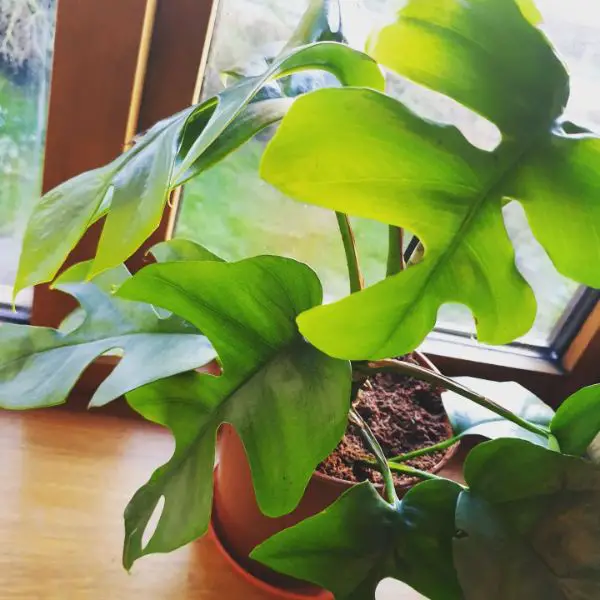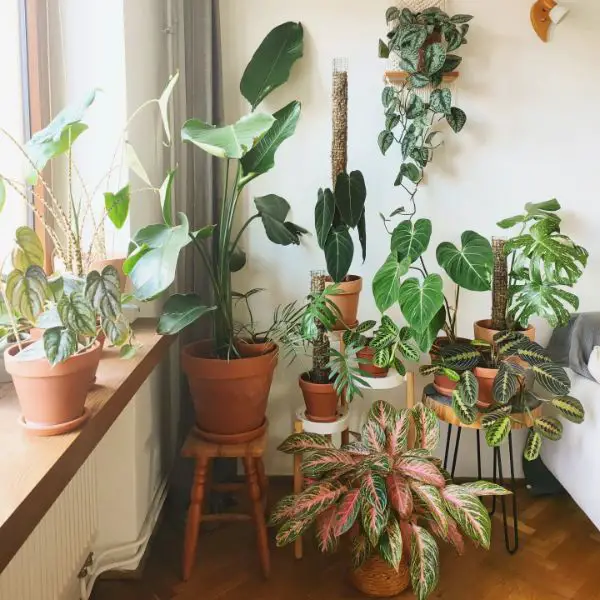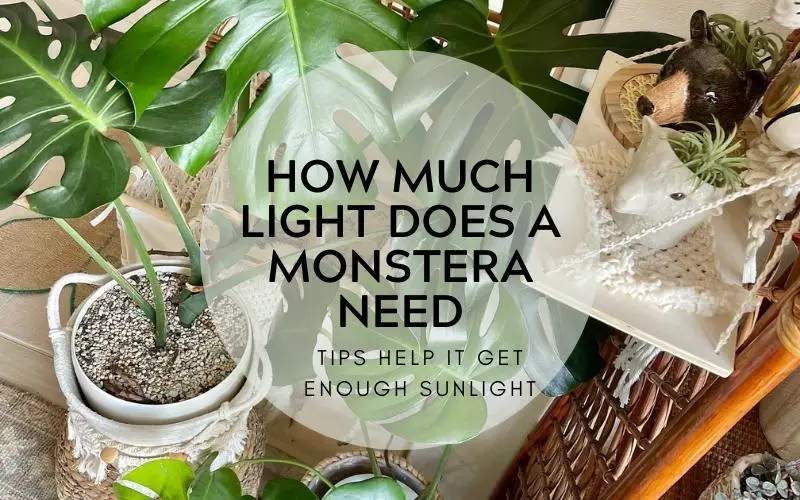Hey there, my fellow plant enthusiasts! I’m excited to share some tried-and-true insights about the Monstera plant. I won’t pretend to be a green-thumb expert, but I’ve picked up a few handy tips. Let’s explore how much light Monsteras need and whether they’re sun-soakers or prefer a bit of shade.
In This Article
How Much Light Do Monsteras Need?
Your Monstera will be content with about 5-8 hours of bright, indirect sunlight daily – not too little, not too much, just perfect. You can place your Monstera pots near a window, but don’t let direct sunlight scorch their leaves.

These ideal light conditions keep your plant’s leaves looking lively with no sunburn issues. Think of it as a daily energy boost for your Monstera deliciosa plant.
However, here’s the twist – not everyone has the knack for nailing that perfect light setup. It’s a bit of a learning curve, and different plants, including our Swiss Cheese plant, have their own reactions to various light levels. Trust me, I’ve had my fair share of hiccups with this, too, but now I’ve got the hang of it, which I’ll share right below.
What are the Signs of Too Little or Too Much Light for Your Monstera?
Light is the lifeblood of plants, and your Monstera is no exception. It’s like their daily bread, except it’s sunlight. Think of it as a spectrum, from low to medium to high, and how much light your Monstera gets can make or break its day.
Signs of Too Little Light for Your Monstera
- Leggy Growth: When your Monstera stretches its limbs like it’s doing morning yoga, it’s a hint that it desperately needs more light for healthy leaf growth.
- Small or Fewer Leaves: If your Monstera is being a bit stingy with the leaf production, serving up smaller or fewer leaves, it’s your plant’s gentle way of saying, “I could use some more sunshine here” for sufficient light.
- Yellowing Leaves: When your Monstera starts turning yellow or loses that vibrant green glow, consider it a call for a brighter spot to maintain its green color.
- Slower Growth: Is your Monstera moving at a snail’s pace when it comes to growing? It’s time to interpret that as an invitation for more light to supercharge its growth engine and avoid slow growth.
Signs of Too Much Light for Your Monstera
- Leaf Browning: Those brown spots on your Monstera’s leaves are like sunburns. They occur when the plant is exposed to direct sunlight for extended periods without any protection, resulting in leaf burn.
- Fading Foliage: If your Monstera is starting to look washed out losing its vibrancy, it’s an SOS signal that it might be getting too much direct sunlight, which leads to fading foliage.
- Crispy Edges: When you notice dry, crispy edges on the leaves, your Monstera’s not asking for chips; it’s feeling dehydrated due to intense light and low humidity, indicating a lack of humidity.
- Wilting or Drooping: If your Monstera decides to take a nap and starts drooping, it’s a sign it’s feeling the heat.
So, there you have it, your Monstera’s way of communicating with you about its lighting preferences in various lighting conditions. It’s all about finding that perfect balance to keep your green buddy happy and thriving!
How To Know If My Monstera Is Receiving Enough Light
Your Monstera Deliciosa can be a silent communicator, but it drops some hints when it’s happy with its light situation. Here’s how I decipher the plant’s happy language:
- Vibrant Leaves: Healthy, well-lit Monsteras boast lush, vibrant green leaves. If your Monstera’s leaves are looking rich and full of life, it’s a good sign it’s meeting its Monstera lighting requirements.
- New Leaf Growth: Keep an eye out for new leaves sprouting regularly. If your Monstera keeps producing fresh, large leaves, it’s content with Monstera light conditions.
- Minimal Leggy Growth: Minimal stretching or leggy growth indicates that your Monstera is getting sufficient sunlight.
- Consistent Leaf Size: When your Monstera’s leaves are consistent in size and spacing along the stem, it suggests a balanced light environment.
- Healthy Roots: While not a direct light indicator, healthy roots can also hint at good growth conditions. If your Monstera has robust, well-developed roots, it’s likely receiving adequate light to support its overall growth.
So, keep an eye on these signs, and you’ll be well on your way to ensuring your Monstera gets the right amount of light to thrive. It’s like having a silent conversation with your plant – and your Monstera will thank you with its lush, stunning foliage!
How to Ensure Your Monstera Gets Enough Light?
Ensuring your Monstera’s light condition is crucial for a healthier, more vibrant plant, and it’s a journey filled with discoveries. Whether you’re nurturing it indoors or letting it soak up the outdoor glory, here are some tips that have worked for me and made me feel more connected to my green companion.
Outdoor Light Tips
- Choose the Right Spot: Finding the perfect spot with the right amount of Monstera light is like uncovering a hidden treasure. Bright, indirect sunlight is the key. But I noticed that even in low-light conditions, my Monstera still displays a healthy color; just make sure it can bask in at least 5 hours of sunlight each day.
- Avoid Direct Sunlight: I once slipped my mind and left my Swiss cheese plant on the window sill for the whole summer day. Only a day after that, signs of leaf burn appeared. Those lovely Monstera leaves are quite sensitive to direct sunlight, so ensure your outdoor Monstera is shielded from the midday sun.
- Rotate Your Plant: Giving your Monstera a little spin now and then ensures that every leaf gets its share of the spotlight, promoting growth that’s well-balanced and full of life while meeting Monstera lighting requirements.
- Shade During the Hottest Hours: Providing shade during the hottest hours is like a refreshing break for your Monstera. It protects your plant from the lack of humidity and excessive heat, ensuring it gets the right amount of light.
Related Post: How to propagate Monstera – 6 Methods To Try
Indoor Light Tips
- Place near a Bright Window: Positioning your Monstera near a bright window will make their day. I usually place them on a north-facing window, but an east-facing one is just perfect for a morning sunbath.

- Use a Grow Light: In low-light situations, supplement your Monstera’s light intake with a grow light. Doing so gives your plant extra energy to counter the lack of natural sunlight.
- Avoid Overwatering: Adapting your watering routine to your Monstera’s indoor environment is crucial. Your Monstera won’t require as much water in indoor environments with lower light intensity. Adjust your watering routine to match the lower energy consumption, supporting its healthy growth.
- Monitor for Signs: Keeping a watchful eye on your Monstera for signs of too little or too much light allows you to adapt its indoor environment for optimal growth.
FAQs
Is Bright, Direct Light Good For Monstera?
I’ve learned from experience that bright, direct light isn’t the best for Monstera. They do much better with bright, indirect sunlight. Direct sun was the way to go, but it can lead to issues like leaf burn. So, my advice is to go for that lovely filtered sunlight instead – your Monstera will thank you with those stunning holey leaves!
What Should I Do if My Home Lacks Light for Monstera?
I’ve been there, too. It can be challenging, but there are ways to keep your plant happy and healthy.
- Artificial Lighting: I’ve found that grow lights can make a difference. They provide the right light spectrum for your Monstera, and my plant has responded well to them.
- Adjust Watering: In lower light conditions, be mindful of your watering routine. Overwatering can be a common mistake in low-light settings.
- Rotate Your Plant: I make it a habit to give my Monstera a quarter-turn regularly. This ensures that all sides get their share of the available light and helps maintain a balanced growth pattern.
- Prune and Shape: Pruning has become a regular part of my Monstera care routine. It helps my plant focus its energy on healthy growth rather than stretching toward inadequate light.
- Keep the Surroundings Bright: I’ve also noticed that light-colored walls and furnishings in the room can benefit my ornamental. They help reflect any available light, creating a brighter environment for my Monstera.
- Monitor Signs: Closely monitor the Monstera’s leaves and growth and quickly adjust the lighting setup if you notice any signs of leggy or pale growth.
Conclusion
Our Monstera journey has been nothing short of a delightful adventure filled with unexpected discoveries. Remember, it’s all about understanding the unique Monstera light needs. As you care for your leafy friend, you’re not just growing a plant; you’re nurturing a thriving relationship with a beautiful piece of nature. Keep those leaves lush and vibrant, and happy growing, my friends!


